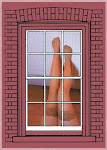Happy es la búsqueda del placer evitando el dolor. Obtener lo que queremos. Mantener lo que tenemos. Desear. Ceder a la tentación. Adicción. Lujuría. Amor. Sexo. Agonía. Felicidad. Creencia. Fe. Comedía.Tragedía. Reirse hasta llorar. Bailar hasta caer rendido. Las palabras que usa Nigel Charnock para explicar esta pieza.
Happy está ambientado en el contexto de un pueblo polaco –no realista, entre lo folclórico y ‘una visión moderna’, y un tanto estereotipado tal como lo imaginó el coreógrafo (por ejemplo: los polacos beben demasiado vodka, se emborrachan ...).
Pero Happy no me pareció alegre: es más bien triste y violento. Tiene algún momento muy divertido, pero solo porque Charnock es un gamberro. Yo soy de la “vieja escuela” y no soy fan de Physical Theatre. Prefiero ver bailarines con los pies estirados, pero si el vuelve a Madrid con otro espectáculo probablemente iré para ver lo que ha ingeniado.
NOTAS:
Nigel Charnock, miembro fundador de DV8, es una de las personalidades más interesantes de la danza europea. “Un tesoro nacional” según The Arts Council of England, tildado “el chico malo” de physical theatre por los críticos ingleses.
Physical Theatre incluye una gran variedad de estilos –puede incluir danza, teatro, clown, mimo,mascaras,circo etc.
.......................................................................................................
Succumbing to temptation. Addiction. Lust. Love. Sex. Agony. Happiness. Belief. Faith. Comedy. Tragedy. Laughing until you cry. Dancing until you drop." These are the words Nigel Charnock uses to describe this piece.
Happy has been situated in the context of a Polish village as imagined by Charnock -its somewhere between traditional folklore and a 'modern vision' becoming a perfect background for stereotypical behaviour as seen with an outsider´s eye. (eg. Polish people drink too much vodka, they get drunk...)
I didn´t find Happy happy, it was sad and violent but because Charnock is naughty and irreverent it had its humour too. I´m 'old-school', not a physical theatre fan and prefer watching trained dancers with pointed feet but if he comes to Madrid again, I´ll probably go see what he´s brewed up.Notes:
Nigel Charnock, founder member of DV8, is a celebrated star performer throughout Europe - a national treasure according to the Arts Council of England, branded "the unreconstructed bad boy of physical theatre" by London Metro
Physical Theatre includes a wide variety of styles, approaches, aesthetics – can include dance-theatre, movement theatre, clown, puppetry, mime, mask, vaudeville, and circus.







